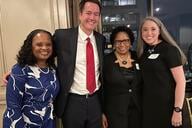You have /5 articles left.
Sign up for a free account or log in.
Identifying trends is an important part of my work in higher ed media relations. I am always on the lookout for connections between student and faculty experiences, as well as institutional solutions to problems across higher ed institutions to consider for potential pitches. So, when four different universities mentioned the same new priority to me in a single week, I took notice. Each talked about wanting to take a more intentional approach to sharing faculty research in a way that was impactful and would matter to people. One even shared details of a pilot program specifically focused on sharing science research through public scholarship.
This realignment of communication priorities isn’t necessarily a trend I would pitch to a reporter, but it is something I think will become even more critical as institutions face growing pressure to prove their value to society. We’ve seen evidence of this shift in big and small ways as institutions try to make the case for federal research funding, billions of dollars of which have been cut by current administration. Perhaps the most well-known example is the Harvard homepage redesign in April, which not only highlighted important research but also clearly articulated why it mattered and what the consequences would be if funding was lost. Since then, others have followed suit, and more intend to, as evidenced by my recent conversations.
This shift is necessary. And while money is a huge part of the reason why, it’s not the only reason. The research happening on our campuses impacts real people in real ways. But not enough of the public realizes it—and without public opinion in our favor, the fight for resources becomes that much harder. We’ve known this to be an issue for a long time and have failed to address it in meaningful and widespread ways. But spending time casting blame or making excuses about why this is true would be a waste of energy at this point, further delaying us from correcting course. The reality is that how and where we communicate the critical research happening at our institutions matters just as much as the research itself. And this is exactly where we need to rethink our approach.
While changing public perception will take time, especially in a political environment that is aggressively pushing a different narrative, there are some steps you can implement immediately to start to move things in the right direction.
Tell People What They Want to Know
One of the most common ways I become aware of new research is by receiving a forwarded email with a journal name and article title, along with a request to help get news coverage for the findings. I know that communicators on campus have the same experience, because we’re often copied on the same emails. But journal names—even the most prestigious in the world—and article titles don’t mean much, if anything at all, to people. When it comes to figuring out what’s newsworthy, what I want to know isn’t how prestigious the journal is or what the complicated title of the journal article is, but rather how the findings will impact the public. I want to know why anyone outside the discipline should care.
Most research touches people in some way, but we often fail to make the connection clear for people. So, whether you are a faculty member sharing your work or a communicator tasked with getting news coverage for research, the first question you should ask before sharing anything is: Who would care about this? Think about their demographics—age, gender, profession, geographic location, etc. What specific findings are most relevant to them? Sometimes that won’t be what the researchers are most excited about. (Often, it’s not.) But if people can’t connect to something that matters to them personally, they won’t pay attention, and then you’ve lost them before you’ve even begun. In higher ed, we tend to tell people what we want them to know versus what they’re looking to hear. That tendency doesn’t serve anyone well.
Tell Them in Their Language
Once you’ve identified what your audience cares about, be sure you’re explaining things to them in terms that make sense to them. We all know we should stay away from jargon, but it’s not as simple as that. You also need to make sure you find points of connection to the audience.
I had the opportunity recently to participate in a workshop through the Alan Alda Center for Communicating Science. One of the exercises was to explain our work to a partner in a one-minute speech. After, we asked our partners to explain our work back to us. It was eye-opening to hear what others took away, and useful in terms of refining our messages. Over the course of the exercise, we had the opportunity to rework our speeches several times, each time soliciting feedback from our partners to make sure our messages were being received the way we intended. Throughout the process, jargon we weren’t aware of using was eliminated, language was simplified and connections were drawn to the audience through stories and examples.
What we think we are communicating isn’t always what’s being understood, or what the audience actually cares about. To get it right, consider running things by a member of your targeted audience for feedback. We do this for other marketing messages; why not for research communications?
Tell Them Where They Are
The media has changed dramatically in recent years and continues to do so. While The New York Times is still hugely influential in many ways, it may not be where your audience is. Smaller, niche and trade outlets may not have widespread name recognition in some academic circles, but they do have tailored audiences who are seeking out very specific information. Go to where people are looking for the kind of information you can provide, versus trying to provide it in a spot where people aren’t interested.
In addition to keeping an open mind about news outlets you may not know a lot about, social media is another venue to consider. If the goal is to get academic research into the public sphere, this may be an even better way to reach the masses than traditional media. (Don’t tell anyone I said that.) Lots of faculty members are already doing this, including this chemistry professor from the College of the Holy Cross, who has millions of views of his organic chemistry videos on TikTok. (How’s this for meeting your audience where they are in every way?)
Communicating research impact is no longer optional in higher education—it is necessary for survival. This is not to say that this work hasn’t been happening. It’s something I have helped faculty members from dozens of colleges and universities do on a daily basis for the past 23 years. But how we communicate research matters just as much as the research itself. Those of us in higher ed comms have always known this. The industry needs to capitalize on this momentum and make research communication more accessible to truly highlight its importance as a public service.




